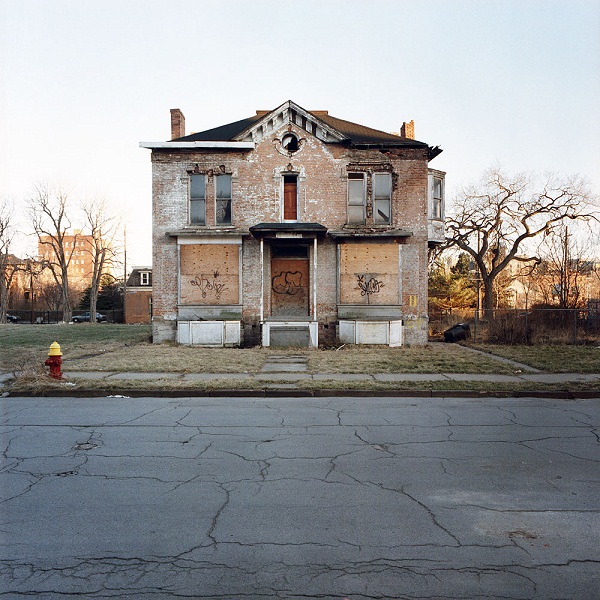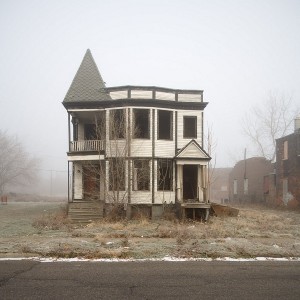Artist of the Week 8/15 – 8/21: Kevin Bauman Exposes ‘100 Abandoned Houses’
Denver-based photographer Kevin Bauman has transformed mere statistics about his hometown of Detroit, Mich. into captivating artwork. With the decline of America’s auto industry, the motor city’s heyday has long since passed. The 138-square mile city — large enough to hold the land masses of San Francisco, Boston, and Manhattan — has diminished from nearly two million citizens to less than 800,000. Bauman’s documentary-style series of photographs, capturing the empty shells of forgotten homes, provides a visual representation of such dramatic evacuation.
100 Abandoned Houses depicts a varied cross-section of Detroit; the depth of the project reflects the longevity of Bauman’s time commitment to the series, as the artist’s personal photography ventures grew into a long-term project that would continue for more than a decade. While he began taking the photographs of the decrepit abodes in the once-affluent neighborhood of Brush Park, Bauman would eventually crisscross his hometown, finding houses that while differing in appearance and history, shared the same tragic end. The 105 images in the series capture the architectural nuances of homes built over the decades as well as a universal sense of neglect and emptiness.
Although a web developer by trade, Bauman has pursued photography for years, specializing in architectural, interior, and industrial photography. His work has been used by a number of commercial clients and publications including The New York Times, The Economist, Urban Outfitters Blog, Apartment Therapy, and The Modern Townhouse. However, Bauman is most well-known for his documentary-style projects, such as Mt. Evans, Lightning, and Small Churches.
In a similar fashion to his Small Churches project, a photography series of unusually compact worship spaces, all the images in Bauman’s 100 Abandoned Houses focus on a single exterior façade each. In one photograph, a stately, red brick Victorian home boasts elegant arches that ironically frame ugly, plywood-covered doors and windows. In another, a minimalistic box of a contemporary house is ornamented by the vibrant shock of a wilting, shredded plastic tarp. Each photograph juxtaposes elements of what was with what is. As Detroit has changed, the individual units that composed the once-industrious and booming city have endured their own unique transformations, and Bauman presents these haunting contrasts simply, with little personal commentary — none of the individual images have titles.
Bauman discusses the photography series that has provoked much response, both praiseful and critical, from Detroit natives and outsiders alike.
GALO: You specialize a lot in architectural photography and have even completed two extensive projects that are focused solely on the exterior facades of buildings, 100 Abandoned Houses and Small Churches. Why are you drawn particularly to these subjects as opposed to portraits or other people-centered shots?
Kevin Bauman: I suppose there [are] a couple of reasons. One, my father was an architect for 35 years or so, so I guess there’s a little of an impulse there. I was also interested in the architecture as far as what it shows in terms of the impact of the economy, the lack of leadership in the city and state governments. The decay really shows the impact [that] all of those things have had on the city. I focus on buildings more than things with people because I was more interested in dealing with things without people than things with [them]. My personality, at least when I started, was more quiet and introverted.

Kevin Bauman’s “100 Abandonded Houses” series. Photo Credit: Kevin Bauman.
GALO: Are you trying to bring beauty to urban decay by photographing the abandoned houses?
KB: I think it’s certainly something I thought about when I started — how could these grand houses be in such a state of disrepair? I was interested in how it related to what I mentioned before, the political and economic [conditions] and the leadership of the area and how those things impacted the city, but I also did find them to be interesting visually, so that was definitely something.
I tried to pick houses that would have a visual impact. I would try to go out in the snow or fog, things like that. As the project progressed, I branched out and tried to just photograph the big, majestic houses of Brush Park. I just kind of wanted to show the variety of the houses that had been abandoned and show that it wasn’t just certain areas, but it was all over Detroit and in all different economic layers of Detroit. There are very, small inexpensive houses, houses that would have been inexpensive even when times were good, all the way to really huge houses that must have cost a fortune when they were originally constructed.
GALO: You started your 100 Abandoned Houses project in Detroit but currently live in Denver. You even surpassed your initial goal of 100 photographs. Did you continue the project elsewhere in the country?
KB: The only other cities were cities within Detroit. Within Detroit, there are two cities, Hamtramck and Highland Park. Those cities were included because there is no delineation between those cities and the city of Detroit. If you were driving through, the only differentiation would be a sign that says “Welcome to Highland Park.” Otherwise, you wouldn’t notice [the difference].

Kevin Bauman’s “100 Abandonded Houses” series. Photo Credit: Kevin Bauman.
GALO: Why did you decide to keep your project within the Detroit area?
KB: Some people like to go where they know best, and some people like to go to places that are more exotic. I try to stick with the things I know best. I stuck with the city that I, at least then, knew best. It’s a city where I’d spent time wondering about the history. I’d hear stories from my parents and grandparents about how great the city used to be and that all played into me wanting to understand the city better. There was also the convenience, in a way. You can do a much more in-depth project if it’s right there. If I had to travel, it would have taken more time. I didn’t have the funds to travel. It took me 10-plus years in Detroit to get a cross-section of the city.
(Article continued on next page)

